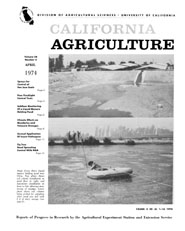All Issues

Cover:
Shady Grove Dairy liquid manure holding pond near Chino. Top photo shows soil column installation on pond floor to right, and manometer installation on levee to left, allowing monitoring of seepage. Lower photo shows soil column being probed for sampling when pond was full with 8 ft. of dairy sewage.
April 1974
Volume 28, Number 4
Volume 28, Number 4





